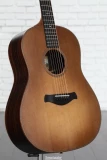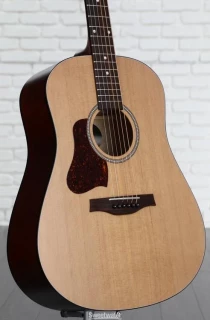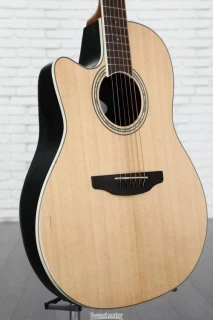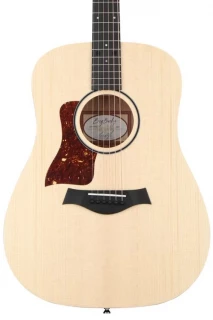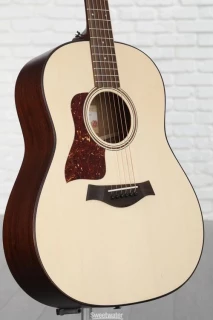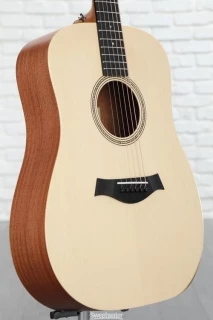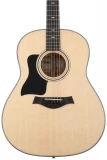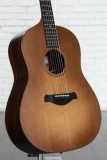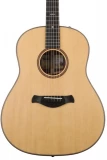Taylor 717e Grand Pacific Builder's Edition V-Class Left-handed Review
Featured Deal
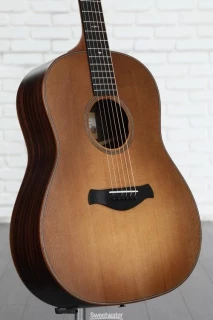
From $3299.00
Get DealTaylor 717e Grand Pacific Builder's Edition V-Class Left-handed
Left-handed 6-string Acoustic-electric Guitar with Torrefied Sitka Spruce Top, Indian Rosewood Back and Sides, Mahogany Neck, Ebony Fingerboard, and Taylor ES2 Electronics - Wild Honey Burst
$3,299.00
$2,309.30
$2,969.10
Taylor 717e Grand Pacific Builder's Edition V-Class Left-handed For Sale
Most Popular Left-handed Acoustic Guitars
Seagull s S6 Cedar Original Left-Handed
6-string Acoustic Guitar, Left-handed, with Solid Cedar Top, Cherry Back and Sides,... read more
Ovation Celebrity Standard CS24L-4 Mid-Depth Left-handed
Left-handed 6-string Acoustic-electric Guitar with Solid Spruce Top, Lyrachord Back and Sides,... read more
Big Baby Taylor Left-handed
Left-handed 6-string Acoustic Guitar with Sitka Spruce Top, Walnut Back and Sides,... read more
Taylor American Dream AD17e Left-Handed
6-string Acoustic-electric Guitar with Spruce Top, Ovangkol Back and Sides, Mahogany Neck,... read more
Taylor Academy 10e Left-handed
6-string Acoustic-electric Guitar, Left-handed, with Sitka Spruce Top, Layered Sapele Back and... read more
Specifications |
|||
|---|---|---|---|
| Brand | Taylor | ||
| Category | Left-handed Acoustic Guitars | ||
| String Type: | Steel, | ||
| Number of Strings: | 6, | ||
| Body Shape: | Round Shoulder Dreadnought, | ||
| Left-/Right-handed: | Left-handed, | ||
| Color: | Wild Honey Burst, Natural, | ||
| Finish: | Silent Satin, Satin, | ||
| Top Wood: | Torrified Sitka Spruce, | ||
| Back & Sides Wood: | Indian Rosewood, | ||
| Body Bracing: | V-Class, | ||
| Binding: | Wood, | ||
| Neck Wood: | Tropical Mahogany, | ||
| Neck Shape: | Compound Carve, | ||
| Radius: | 15", | ||
| Fingerboard Material: | West African Ebony, | ||
| Fingerboard Inlay: | Mother-of-pearl Arrowheads, | ||
| Number of Frets: | 20, | ||
| Scale Length: | 25.5", | ||
| Tuning Machines: | Taylor Nickel, | ||
| Bridge Material: | West African Ebony, | ||
| Nut/Saddle Material: | Black Graphite/Micarta, | ||
| Nut Width: | 1.75", | ||
| Electronics: | ES-2, | ||
| Strings: | Elixir PB Medium, | ||
| Case Included: | Hardshell Case, | ||
| Manufacturer Part Number: | A70303401101358S214, A70303401101358S000, | ||
Daily Deals
Taylor 717e Grand Pacific Builder's Edition V-Class Left-handed Reviews
It's not hype - it's just that good.
It's very, very, very hard to write a review on this guitar without sounding like a fanatic. As far as I can tell, about half the Internet thinks Taylor's V-Class bracing is a joke and a marketing scam at best or an unnecessary regression in guitar design at worst, and the other half thinks it's the most heavenly thing ever accomplished in the realm of music. One half thinks that… read more the Grand Pacific is a poorly made, tinny clone of J45's somehow trying to be a D-28, and the other half thinks it's an incredible shape and a leap forward in the innovation of, shall we say, dreadnought-style guitars. It is my assessment that one half of those commenters have played these guitars, and the other half has not. In my personal experience with this instrument, the Grand Pacific 717e does every bit of every thing that Taylor claims it does. I'll boil this down into 3 basic claims. But, before explaining further, I'd like to let the reader know that I *don't* think this means that this guitar is for everyone. It's perfect for many, good for most and maybe not the best pick for some. More on that toward the end. Taylor marketing claims that I have found to be true: 1) V-Class bracing benefits in evenness of response, volume, sustain, and intonation. I'm sorry, but there's really no denying this, and it's clearly apparent from the instant you pick up and start to play. This guitar begs and invites you to play a D major chord at xx-0-14-15-14 and listen to how glorious it is. Inversions and complex chords all the way up the neck sound wonderfully in tune and balanced. There are no weak spots on the fretboard. Every space and note has equal power and body. It's possibly the first dreadnought I've ever played that in no way encourages me to stay behind the fifth fret. It's all there - free, useful, willing and waiting real estate. It's not an exaggeration at all to say that it completely changes the way that you play guitar. There's truly nothing like it. Volume and sustain hold up to the claims, too. This guitar is loud, particularly with a pick (more on that later). The thing I love about it isn't just the increased volume and sustain, it's also the increased balance *of* the sustain - or, more accurately, the pristine and unified note decay across all six strings. When you strum the last chord of a song, you really do hear everything very gently and gradually taper down together, creating a very harmonious, balanced, genuinely enjoyable cooldown effect that's perfect for any conclusion. Of course, if you just don't want that, you can use your hand to mute strings and cut off the note. Not that I think you generally should, but hey. I can think of a few cases where that might be necessary. You can if you want. Linear-ness. I play lead on this like I do on an electric (minus bending). It's just direct and straightforward. The equation is unaffected; I get out what I put in on every fret and every string. It's absolutely amazing. 2) Grand Pacific body shape providing a studio-happy, well-behaved dreadnought sound (including bass response). It's a dreadnought (ish), yes, but it's so *polite*. And I mean that in a good way. It's in no way "unruly", difficult to tame, unpredictable, inconsistent, or indirect. To use one of Andy Powers' illustrations on Shamel Ash, it's like the golden retriever of guitars. It just wants to make you happy. I've performed and recorded with it very low-budget, hobbyist gear (what with COVID and all, Zoom concerts being the way to go), and I'm consistently surprised and amazed at how well this guitar works with even the cheapest and worst microphone setups available. It really shines in just about any context. (And, side note, I really like the electronics as well. ES-2 does not disappoint for live performances or solo arrangements of layering loops.) I personally think that a great part of the reason why it behaves so well in recording contexts is because the V-Class architecture causes a more unified vibration response from the top, propagating sound in a way that causes the frequencies of the sound waves to work together rather than spreading out in a static-y disarray. This also makes mic position relative to guitar much less significant than it is with X-braced guitars, because the response from the instrument going outward is also very linear and direct. It doesn't change much. And the bass response is perfect - standard tight, clear Rosewood response, with an incredible amount of fullness (even when capo'd relatively high up) and no trick puffs of air or undesirable warbles. 3) Grand Pacific body shape "blending" notes, traditional sound (sunset versus noon daylight). The Grand Pacific shape produces precisely the sound it claims to - seasoned, warm, blended, and traditional. Notes do tend to blend together quickly rather than jumping out at you separately and distinctly. As I'll comment on below, this could be a good or a bad thing for you depending on your application. It's a versatile sound that's great for many things, good for most things, and possibly not the best for everything. Other nice things before I go on: The "Silent Satin" finish really is dope. It's awesome. I love how Andy Powers described it when he said that the idea was to reduce or eliminate any "non-musical sounds" coming from contact with the body. That's very well said. Let's clarify: if you rub your hand across almost any surface with any degree of force, you'll make a sound. That's physics - and it would be difficult if not impossible for any finish to change that. This one does, however, *reduce* the sounds that *are* produced, and they're just so darn pleasant. I know that sounds weird, but you really gotta try it. The rounded/chamfered body edges make this guitar incredibly inviting and pleasant to play. One of the reasons I wanted to buy this guitar was because the one I already owned was cool - nothing overly bad or problematic - but it just wasn't that inspiring. It's like, you look at it, and ask, "hey, you wanna play something?" And it looks back at you, and shrugs, and says, "yeah, I guess, if you want." You play a song or two, or four or five, and you ask it, "hey, you wanna keep going?" And it looks at you and says "meh, either way." Nothing negative, but nothing positive either. This guitar begs to be played from the minute you lay your eyes on it - and even more so your hands. It's a very enthusiastic and responsive bedmate, and it's always down. I never, ever want to stop playing it. It's seductive and comfortable and enjoyable and inviting and warm and it never gets tired. It begs you to improve and inspires you to advance and try new projects and skills - partially because you *can* now. The rounded heel *really* makes a difference. I'm not sure how much I personally really care about the compound carve neck and rolled fretboard edges - maybe I subconsciously enjoy them but it doesn't register consciously - but that heel, man. Perfect. Makes frets 12-15 just feet like home. I love it. It's also worth mentioning that it performs stunningly well with a capo. Having said all of these things, I don't this guitar is for everyone. I think it's right for a whole lot of people, absolutely perfect for many, and maybe not the best for some. Let me explain. Let's start with Andy Powers' claim that it creates a traditional, blended sound to notes rather than a modern, vibrant one. That's absolutely true. It also means, quite frankly, that if you're looking for a very articulate guitar for very precise fingerstyle work where you need every note to ring out individually and clearly and every alternate voicing to shine through vibrantly, you might be more satisfied with a spruce/rosewood Grand Auditorium with an armrest or a 300-series mahogany/blackwood Grand Concert. As inviting and wonderful as the increased intonation is for learning to play what you might not on other guitars, I also find myself less inclined to mess around with inversions and learn different and more complex voicings for chords because, again, frankly, it doesn't matter. Or, at least, it doesn't matter as much as it might on other models. Now, single note leads are a totally different story - they're loud, clear, and potent. But an A chord is an A chord regardless of where on the neck you play it, from the open position to past the twelfth fret. It's not that you literally can't hear a difference, it's just not nearly as pronounced as it might be on other models. I'd also say that the response is wonderfully encouraging and enthusiastic when played with a pick - either for strumming, arpeggios, or single note leads - but a bit less so for fingerstyle. To be very clear here, I think it does just fine for fingerstyle - but it doesn't "wow" me. I pick with flesh, so take that for what it's worth in relation to your applications, but I find myself having to actively think about plucking the strings a bit harder to get the volume and response I'd like out of it when playing fingerstyle. I think it's just fine for fingerpicking chords under vocals - it definitely gives you enough response and definition for that - but if that's *all* you play, or if you're looking for a guitar to play complex solo acoustic instrumental fingerstyle pieces with delicate passages of intricate movements, this may not be your girl. In summary, I'd say it's perfect for the flatpicker who plays fingerstyle about 30-40% of the time, or the straight-up strummer, or the bluegrass lead player, and especially the versatile singer-songwriter looking for the one guitar to do it all and perhaps intimate replicating the older sounds that inspired him, but it's certainly not outright designed for the modern fingerstyle jazz player who wants to play 27 different versions of a Dm7 chord in one song and have the world stare in amazement as it beholds his incredible technical abilities. It's a great guitar to be at the very center of someone's arsenal, and it does *most* things *very* well - especailly strumming, flatpicking, and solo acoustic singer-songwriter tunes - but it doesn't shine at everything. And no guitar that I know of does. It's probably not the last guitar I'll ever buy. I'll probably get a Grand Auditorium one day for note separation and clarity, and I'll probably get a mahogany GC for fat, juicy leads and fingerstyle, and then I might feel like I've got a six string for everything. But the 717e will always be the center of the arsenal, the coup-de-grace, the centerpiece, the instrument I start with before deciding if something else might be more appropriate for a particular application. Maybe it will be for you too.
Taylor 717e Grand Pacific Builder's Edition V-Class Left-handed Questions and Answers
No Questions Yet.



